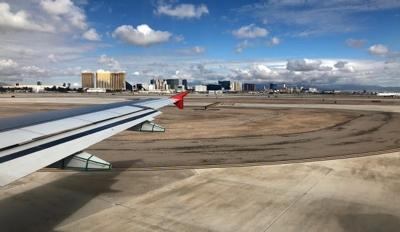Fri, Apr 25, 2025
DCA Accident Spurs Moves To Prevent Similar Traffic Conflicts
The FAA published a media update concerning actions it is taking in response to the January midair collision between a helicopter and commercial airliner at Reagan Washington National Airport in D.C., outlining some initial solutions coming out of ongoing internal rotorcraft safety roundtable discussions. Some immediate actions were implemented to permanently restrict non-essential helicopter traffic and to eliminate mixed traffic in the vicinity of the airport.

The collision exposed hazards involving the mix of helicopters and fixed-wing aircraft at DCA, and the FAA immediately began examining other hotspot airports with charted routes for both helicopter and fixed-wing traffic.
The FAA first focused on Harry Reid International Airport (LAS) in Las Vegas, Nevada due to issues that immediately emerged in the analysis.
One example is that agreements with local helicopter operators require them to avoid arrival and departure corridors that lack defined lateral or vertical measurements. Another is that tower controllers do not issues traffic advisories between returning air tour helicopters and arriving or departing airplanes. This results in routine lack of compliance with Class B separation rules.

The agency immediately implemented positive control over helicopters and began issuing more traffic advisories. This resulted in the number of traffic alert and collision avoidance system reports fell off by 30% in just three weeks.
The FAA is planning additional actions at LAS, and is continuing to analyze other airports as well for issues that, in their assessment, require immediate actions.
An additional item noted by the FAA is that mixed traffic refers to not just airplanes-helicopters, but also mixed operations for example, between slower and faster moving airplanes. The agency is analyzing potential traffic conflicts around closely-spaced airports such as at Hollywood Burbank (KBUR) and Van Nuys (KVNY), airports that are less than ten miles apart, serve a wide mix of aircraft, and have closely-spaced arrival and departure paths.
More News
Airplane Bounced About 3 Ft Then Touched Back Down And Then, With No Brakes Applied, The Airplane Began Veering To The Left Analysis: The pilot entered the airport traffic pattern >[...]
Aero Linx: British Microlight Aircraft Association (BMAA) The primary focus within all aviation activity is SAFETY. In all aspects of our sport SAFETY must come first, whether it b>[...]
From SnF25 (YouTube Edition): William Wynne Builds Practical Aircraft Engines on the Corvair Platform Seeking an affordable alternative to the traditional aircraft engine options, >[...]
How To Get A Story On Aero-TV News/Feature Programming How do I submit a story idea or lead to Aero-TV? If you would like to submit a story idea or lead, please contact Jim Campbel>[...]
From 2023 (YouTube Edition): Bridge of CiES CiES Inc. is a Bend, Oregon-based designer and manufacturer of modular embedded aircraft systems and sensors. The company’s fuel-l>[...]
 NTSB Final Report: Aviat A1
NTSB Final Report: Aviat A1 ANN's Daily Aero-Linx (07.08.25)
ANN's Daily Aero-Linx (07.08.25) Classic Aero-TV: Fly Corvairs Reliable Engine Alternative
Classic Aero-TV: Fly Corvairs Reliable Engine Alternative ANN FAQ: Contributing To Aero-TV
ANN FAQ: Contributing To Aero-TV Classic Aero-TV: CiES Fuel-Quantity and e-Throttle Systems Praised
Classic Aero-TV: CiES Fuel-Quantity and e-Throttle Systems Praised




